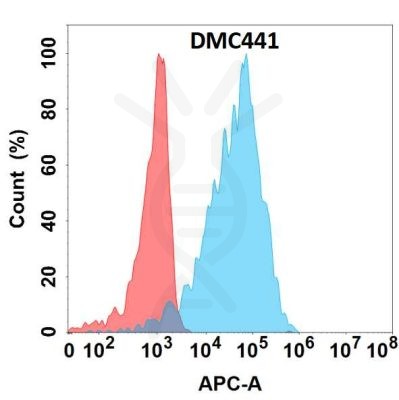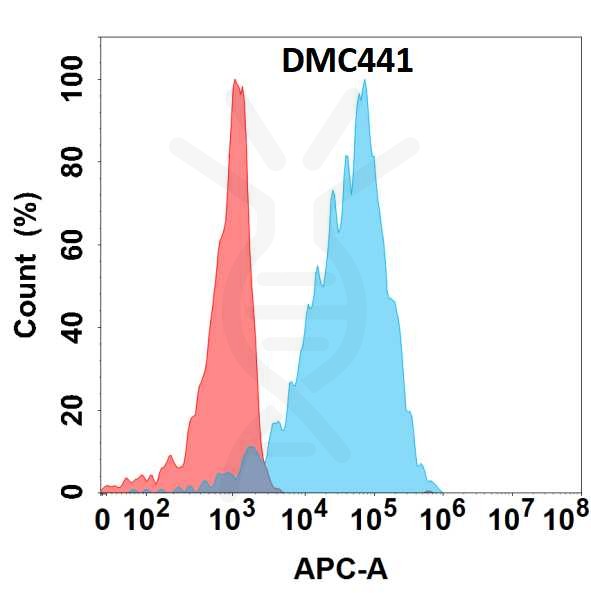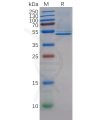| Clone ID | DMC441 |
|---|---|
| Target | |
| Synonyms | AIM; API6; CT-2; hAIM; PRO229; SP-ALPHA; Spalpha |
| Host Species | Rabbit |
| Description | Anti-CD5L antibody(DMC441); IgG1 Chimeric mAb |
| Delivery | In Stock |
| Uniprot ID | O43866 |
| IgG type | Rabbit/Human Fc chimeric IgG1 |
| Clonality | Monoclonal |
| Reactivity | Human |
| Applications | Flow Cyt |
| Recommended Dilutions | Flow Cyt 1:100 |
| Purification | Purified from cell culture supernatant by affinity chromatography |
| Formulation & Reconstitution | Lyophilized from sterile PBS, pH 7.4. Normally 5 % – 8% trehalose is added as protectants before lyophilization. Please see Certificate of Analysis for specific instructions of reconstitution. |
| Storage & Shipping | Store at -20°C to -80°C for 12 months in lyophilized form. After reconstitution, if not intended for use within a month, aliquot and store at -80°C (Avoid repeated freezing and thawing). Lyophilized proteins are shipped at ambient temperature. |
| Background | Secreted protein that acts as a key regulator of lipid synthesis: mainly expressed by macrophages in lymphoid and inflamed tissues and regulates mechanisms in inflammatory responses; such as infection or atherosclerosis. Able to inhibit lipid droplet size in adipocytes. Following incorporation into mature adipocytes via CD36-mediated endocytosis; associates with cytosolic FASN; inhibiting fatty acid synthase activity and leading to lipolysis; the degradation of triacylglycerols into glycerol and free fatty acids (FFA). CD5L-induced lipolysis occurs with progression of obesity: participates in obesity-associated inflammation following recruitment of inflammatory macrophages into adipose tissues; a cause of insulin resistance and obesity-related metabolic disease. Regulation of intracellular lipids mediated by CD5L has a direct effect on transcription regulation mediated by nuclear receptors ROR-gamma (RORC). Acts as a key regulator of metabolic switch in T-helper Th17 cells. Regulates the expression of pro-inflammatory genes in Th17 cells by altering the lipid content and limiting synthesis of cholesterol ligand of RORC; the master transcription factor of Th17-cell differentiation. CD5L is mainly present in non-pathogenic Th17 cells; where it decreases the content of polyunsaturated fatty acyls (PUFA); affecting two metabolic proteins MSMO1 and CYP51A1; which synthesize ligands of RORC; limiting RORC activity and expression of pro-inflammatory genes. Participates in obesity-associated autoimmunity via its association with IgM; interfering with the binding of IgM to Fcalpha:mu receptor and enhancing the development of long-lived plasma cells that produce high-affinity IgG autoantibodies (By similarity). Also acts as an inhibitor of apoptosis in macrophages: promotes macrophage survival from the apoptotic effects of oxidized lipids in case of atherosclerosis (PubMed:24295828). Involved in early response to microbial infection against various pathogens by acting as a pattern recognition receptor and by promoting autophagy (PubMed:16030018; PubMed:24223991; PubMed:24583716; PubMed:25713983). |
| Usage | Research use only |
| Conjugate | Unconjugated |
| DIMA Disclaimer | All DIMA recombinant antibodies are genuinely generated by DIMA Biotech. They are all under patent application. Any protein sequencing or reverse engineering attempt is prohibited. We are actively scrutinizing all patent application to ensure no IP infringement. |
Anti-CD5L antibody(DMC441); IgG1 Chimeric mAb
Price: 10μg $99.00 ; 100 μg $446.00 ; 500 μg $1340.00
Product Data Dima FAQ
Images Dima FAQ

Figure 1. Flow cytometry analysis with Anti-CD5L (DMC441) on HEK293 cells transfected with human CD5L (Blue histogram) or HEK293 transfected with irrelevant protein (Red histogram).
Related Products
Monoclonal antibodies
SKU: DMC100441B Target: CD5L
Application: Flow Cyt
Price: 10μg $139.00 ; 100 μg $670.00 ; 500 μg $1999.00
Monoclonal antibodies
SKU: DMC100441P Target: CD5L
Application: Flow Cyt
Price: 100 test $550.00
ECD Proteins
SKU: PME100599 Target: CD5L Tag: C-6×His Tag
Price: 10μg $82.00; 50μg $320.00 ; 100 μg $480.00



